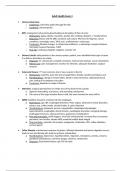Adult Health Exam 3
Urinary Diversions:
o Cutaneous: urine flow pulled through the skin
o Continent: internal pouch
BPH: enlargement of prostate gland leading to disruption of flow of urine
o Risk factors: aging, obesity, inactivity, alcohol, ED, smoking, diabetes, 1° family history
o Diagnosis: history and PE, DRE, urinalysis and culture, PSA level (0-4ng/mL), serum
creatinine, neurologic exam, TRUS scan, uroflowmetry, cystoscopy
o Treatment: lifestyle changes, 5a-Reductase inhibitors, a-adrenergic receptor blockers,
minimally invasive therapies, TURP
o Post-Op: continuous bladder irrigation, monitor I/O
Urinary Calculi: solid particles in the urinary system, painful, once identified what type of stone
it is dietary alterations are made
o Diagnosis: CT, ultrasound, complete urinalysis, retrieval and analysis, serum chemistries
o Patient care: pain management, monitor for infection, adequate hydration, surgical
removal
Colorectal Cancer: 3rd most common site of new cancers in the US
o Risk factors: inactivity, poor diet (not enough fiber), obesity, alcohol and tobacco use
o Manifestations: change in bowel habits, blood in stool, tenesmus, abdominal/rectal
pain, feeling if incomplete evacuation
o Treatment: depends on stage of disease
Ostomies: surgical opening from an inside area of the body to the outside
o Sigmoid, descending, transverse, and ascending colostomies
o The more of the large intestine there is left, the more formed the stool will be
GERD: backflow of gastric contents into the esophagus
o Risk Factors: age, IBS, esophageal disorders, PUD, angina, obstructive airway disorders,
tobacco use, coffee intake, alcohol intake, H. pylori infection
o Manifestations: dyspepsia, pyrosis, regurgitation, dysphagia/odynophagia,
hypersalivation, esophagitis, dental erosion, esophageal ulceration, laryngeal damage,
esophageal strictures, adenocarcinoma, pulmonary complications
o Non-pharmacologic: avoid triggers, avoid LES relaxing foods, increase fiber to promote
peristalsis, low fat diet, elevate HOB, maintain healthy body weight
o Pharmacologic: antacids, H2 receptor antagonists, Prokinetics, PPIs, reflux inhibitors,
surface agents
Celiac Disease: autoimmune response to gluten, inflamed intestinal wall where digestion occurs,
leads to non-functioning villi, leads to systemic malnutrition
o Manifestations: depression, hypothyroidism, migraines, osteopenia, anemia, seizures,
peripheral paresthesias, red/shiny tongue, diarrhea, steatorrhea
o Diagnosis: food/family history, IgA tTG lab work
, Hepatitis A: fecal-oral transmission, contaminated food or water, contact w/ infected stool
Hepatitis B: blood transmission, unprotected sex, mother to infant, contact m/ infected blood,
IV drug use
Hepatitis C: blood transmission, IV drug use, contact w/ infected surfaces, unprotected sex
Hepatitis D: must be co-infected with HBV, IV drug use, unprotected sex
Hepatitis E: fecal-oral transmission, contaminated food or water
Hepatitis Manifestations: general malaise, flu-like symptoms, decreased appetite, clay-colored
stool, dark urine, jaundice, vomiting, ascites, thin extremities
Hepatitis Management: liver biopsy to diagnose, contact precautions, elevated diet, medical
management, avoid alcohol, limit transmission to others at home, avoid sex until negative
antibody test
Osteoporosis: reduced bone mass, deterioration of bone matrix, and diminished bone strength.
Osteoclast activity > osteoblast activity, bones are more porous, brittle, and fragile. Most
commonly occurs as compression fx
o Risk Factors: small-framed women, age, inadequate calcium/vitamin D, bariatric surgery,
malabsorption diseases, protein, excess alcohol/caffeine/carbonated beverages,
sedentary lifestyle
o Diagnosis: poor posture (kyphosis), DEXA, x-ray, CT scan, Ultrasound, Labs, Vit D and
serum calcium
o Management: Vit D (600 units/day), Calcium (1000 mg/day), weight bearing exercise
(30min/day)
o Pharmacologic: calcium supplements, bisphosphonates, estrogen agonists/antagonists,
medroxyprogesterone, calcitonin, teriparatide
Obesity: BMI > 30, Class 1: 30-34.9, Class 2: 35-39.9, Class 3: >40 (25-29.9 BMI is overweight)
o Lifestyle: increased activity and decreased calories
o Pharmacologic: GI Lipase Inhibitor (orlistat), 5-HT2C agonist (lorcaserin), GLP-1 receptor
agonist (liraglutide), Sympathomimetic amines (phentermine)
o Non-surgical: Vagus nerve blocking, intragastric balloon therapy
o Surgical: (Class 2 and 3 after non-surgical interventions) Roux-en-Y, gastric banding,
sleeve gastrectomy, biliopancreatic diversion w/ duodenal switch
o Post-Surgical Complications: hemorrhage, VTE, bile reflux, dumping syndrome,
dysphagia, gastric outlet obstruction
Type 1 Diabetes: autoimmune destruction of beta cells, body can’t produce insulin
Type 2 Diabetes: increasing inability of the body to use glucose due to insulin resistance, insulin
production impaired over time




